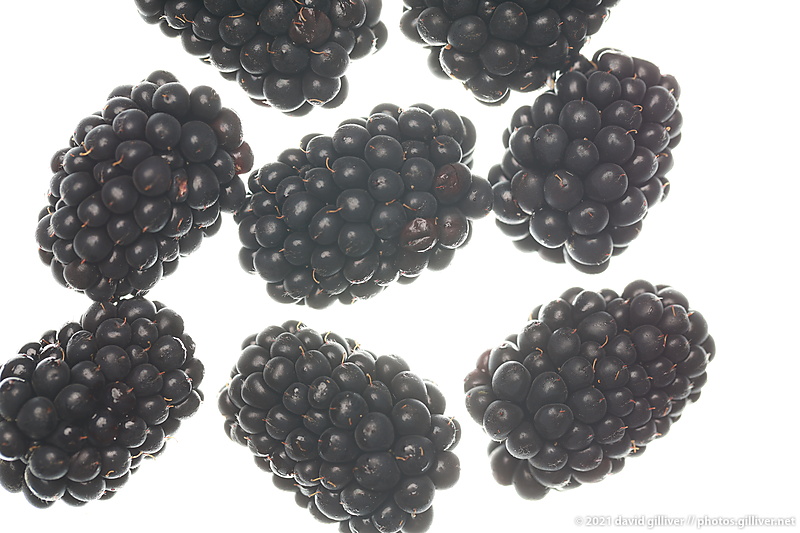When I setup my lighting gear, I’m usually setting it up to take some portraits. The social distancing measures to deal with Covid-19 have reduced my portrait shooting to almost nothing so I’ve occasionally taken on the challenge of photographing objects.
Blackberries are an interesting subject for a lighting exercise. Black objects absorb light so there’s no colour to illuminate. The trick to lighting them is understanding that they are glossy objects that reflect their surroundings. It’s an exercise in creating reflections.
Before setting anything up, I had already decided that I wanted them to be sitting on a clean white background. The easiest way of achieving clean white is to overexpose the background. As I wanted to shoot these as a flatlay with my macro lens, the simple option was to place the blackberries on top of the front of a softbox. As this was going to cause sag, I balanced a sheet of glass between two stools and setup a softbox underneath the glass pointing straight up. Using a proper softbox would help to achieve an even spread of light underneath the blackberries.
To light the blackberries themselves I was simply worried about reflections – I needed to create reflections to show the shape of the tiny, round drupelets. If I had used a bare speedlight, that would have only create a small, bright spot reflection. I really wanted a reflection that wrapped across the surface. I chose my largest modifier, the Godox 120cm umbrella softbox, placed close overhead to ensure it created a large reflection.
This is one of my early shots in this shoot. This shot isn’t too far from what I ultimately wanted to achieve. You can see that my background – a softbox underneath a sheet of a glass – is nicely white, just as I wanted. You can also see glossy reflections in each of the little drupelets. I’m not entirely happy with this shot as it has the basic elements I wanted but there’s some special magic missing. I’m not sure why that is just yet but I will start playing with different elements to see what happens.
In this next photo I decided to try moving my camera lens closer. Maybe these would look more interesting close up?
As you can see, that change was a mistake. My background is still white but now my little reflections are starting to vanish. I quickly realised this was caused by the use of the lens hood – it was acting to shade the blackberries from that big softbox I setup overhead. Normally you would use a lens hood to stop stray light hitting the glass of the lens. This is a controlled lighting situation so it’s less necessary, especially when one bright light is aimed directly up into the lens anyway. I quickly removed the lens hood.
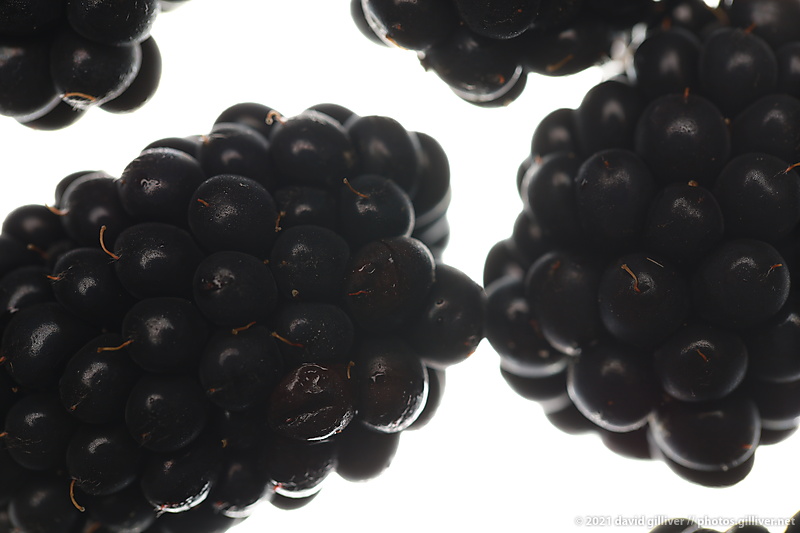
In this next photo I’ve turned up the power of my big softbox above and I’ve moved it a little closer. The bright spots in the blackberries are now similar in brightness to the white backdrop. There’s a better balance to the image. This is starting to look more like what I imagined before the shoot. Is it the best lighting I can do? I don’t know yet so I keep trying things.
In this next photo I’ve decided to turn down the brightness of the softbox underneath. When I saw this image, I felt like an idiot. This looks so much better! When I compare this to the previous shot I realise that there was some white flare happening in my photo, clouding the view of the blackberries. It’s obvious in hindsight but my eye wasn’t experienced enough to see it initially. I’m delighted that the image is now looking the way I originally intended.
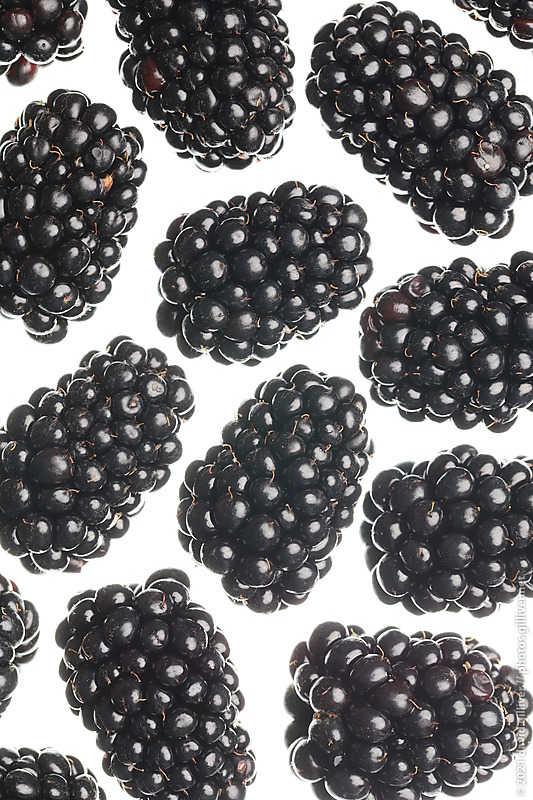
Now that the lighting looks good, I can now experiment with composition. Would the berries look better if they are touching each other? I’m not sure if they do but it’s good to try some shots this way and make the final decision later. It’s good to have choices later.
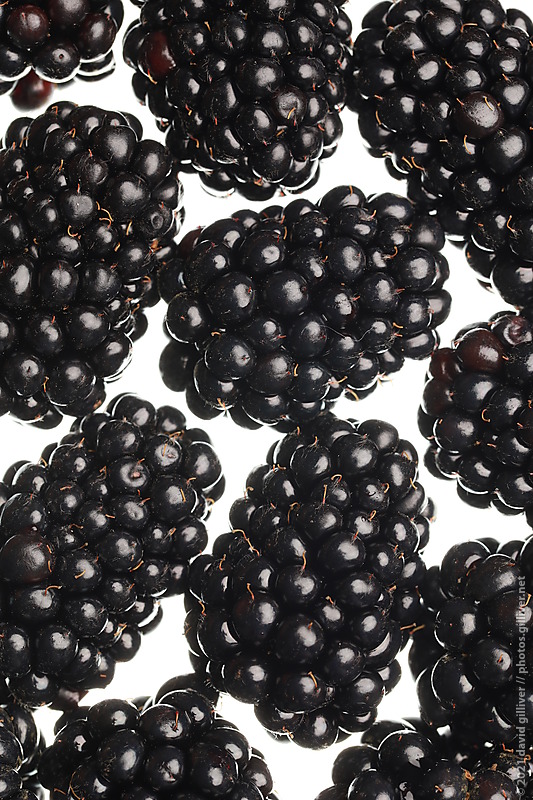
I now decided to try another lighting tweak. If I add a white reflector board beside the berries what would happen?
I was now annoyed to discover that this looked even better. I now have two reflections: the bright reflection on the right is the softbox and the dull reflection on the left is the white board I added. Your eye is seeing white reflections but your brain is interpreting those as glossy parts of a black object. Having two reflections helps the brain understand the spherical shape of these objects.
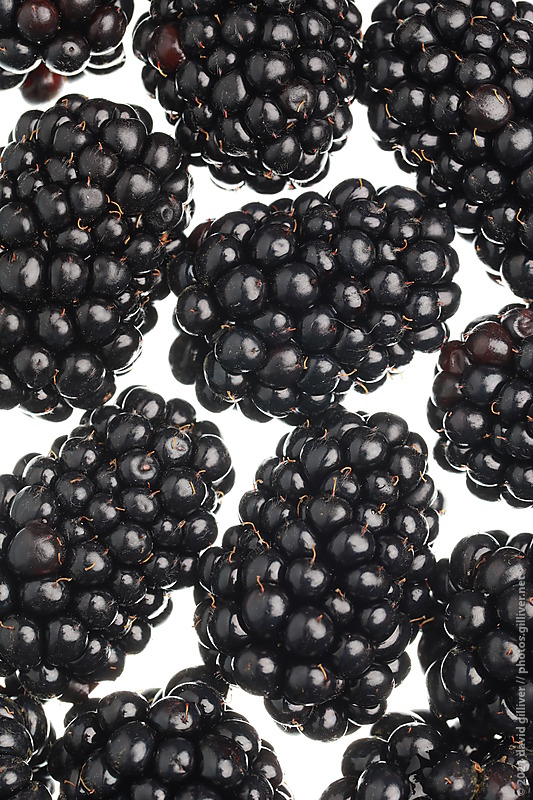
This shoot was a classic example of me thinking I knew what to do beforehand but then during the shoot I learned some practical lessons. All of the theoretical concepts I’ve mentioned above were things I already knew. I had never photographed blackberries before so I had never put those concepts to work. As you can see, I had to shoot a series of variations before I achieved my desired image. There really is no substitute for the experience of making mistakes and learning from them.
Is the final mage correct? That question really depends on your goal. If you were trying to create a dark and moody image of some blackberries, the final image is a disaster. In my case, the final image matches the style of image I aimed to create. The important thing is to have some understanding of how light and reflections work and using that knowledge to achieve your goal.

